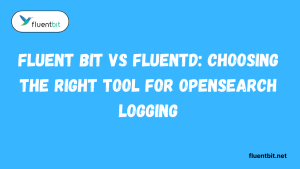Table of Contents
ToggleIntroduction
Fluent Bit is a lightweight and extensible log processor designed for Kubernetes environments, offering full support for processing Kubernetes container logs and enriching them with metadata like Pod Name, Pod ID, Container Name, and more.
It is typically deployed as a DaemonSet in Kubernetes clusters to ensure log collection from every node and POD automatically without manual configuration. The installation of Fluent Bit in Kubernetes is recommended through the official Helm Chart, providing a straightforward deployment process.
In the realm of log monitoring in Kubernetes, various tools like Fluentd, Fluent Bit, Filebeat, Loki, and Kubernetes Logging Sidecars play essential roles in collecting, storing, and analyzing logs from different components and applications within the cluster.
These solutions cater to diverse needs, Helm Charts for Fluentd and Fluent Bit to advanced log aggregation with Loki, offering flexibility and scalability in managing log data effectively.
Kubernetes Logging Architecture involves utilizing logging drivers like Fluentd or Fluent Bit to centralize logs, ensuring efficient log collection, formatting, and forwarding to centralized locations such as Elasticsearch or cloud-based logging services

Helm Charts for Fluentd: Simplifying Fluentd Deployment on Kubernetes
Helm Charts provide a convenient way to deploy Fluentd on Kubernetes clusters, streamlining the installation process and offering customization options through a values file. This guide will walk you through the installation of Fluentd using Helm Charts and explore the key configuration options available.
Installation Pre-requisites
Before proceeding with the installation, ensure that you have the following prerequisites in place:
- Kubernetes cluster version 1.4+ with Beta APIs enabled
- Helm package manager installed in your cluster
- Helm CLI installed on your local machine
Adding the Fluent Helm Repository
To access the Fluent Helm Charts, you need to add the repository to your Helm setup. Run the following command to add the repository:
bash
helm repo add fluent https://fluent.github.io/helm-charts
This command adds the Fluent Helm Chart repository to your Helm configuration.
Installing Fluentd using Helm Chart
Once you have added the repository, you can install Fluentd using the Helm Chart. Run the following command to install Fluentd:
helm install my-release oci://registry-1.docker.io/bitnamicharts/fluentdThis command installs the Fluentd Helm Chart with the release name “my-release.
Configuration Options with Helm Values
The Fluentd Helm Chart provides various configuration options through a values file, allowing you to customize the deployment according to your requirements. Some key configurations available through the values file include:
- Resource allocation (CPU and memory)
- Storage options
- Logging levels
- Plugins and extensions
- Forwarding destinations
By modifying the values file, you can fine-tune the Fluentd deployment to suit your specific needs, such as allocating more resources for high-traffic environments or configuring custom plugins for specialized log processing
Deploying Fluent Bit on Kubernetes with Helm Charts
Helm Charts provide a convenient way to install and configure FluentBit on Kubernetes clusters. This guide will walk you through the installation process and explore the key configuration options available through the Helm values file.
Installing Fluent Bit using Helm Chart
To install Fluent Bit using the official Helm Chart, follow these steps:
- Add the Fluent Helm repository to your Helm setup:
helm repo add fluent https://fluent.github.io/helm-charts
- Install Fluent Bit with the following command:
helm upgrade –install fluent-bit fluent/fluent-bit
This command installs the Fluent Bit Helm Chart with the release name “fluent-bit”.
Configuration Options with Helm Values
The Fluent Bit Helm Chart provides various configuration options through a values file, allowing you to customize the deployment according to your requirements. Some key configurations available through the values file include:
Inputs
Configure the input plugins to specify where Fluent Bit should read logs from, such as:
- Tail plugin for reading container logs from the file system
- Systemd plugin for reading logs from Systemd/Journald
Filters
Apply filters to process and enrich the logs, such as:
- Kubernetes filter to add Kubernetes metadata like pod name, container name, labels, and annotations
- Modify or remove fields using filters
Outputs
Specify where Fluent Bit should send the processed logs, such as:
- Elasticsearch for centralized log storage
- HTTP for forwarding logs to a HTTP endpoint
- Various other outputs like InfluxDB, Kafka, etc.
Lua Scripting Support
Fluent Bit supports Lua scripting for advanced configurations. You can write custom Lua scripts and include them in the values file to perform complex log processing tasks.
By modifying the values file, you can fine-tune the Fluent Bit deployment to suit your specific needs, such as configuring custom inputs, applying specific filters, and sending logs to desired outputs
Benefits of Using Helm Charts for Kubernetes Deployments
Helm Charts offer significant advantages when deploying and managing applications like Fluentd and Fluent Bit on Kubernetes, providing a streamlined and efficient process. This section will delve into the key benefits of utilizing Helm Charts for Kubernetes deployments, focusing on simplified deployment, consistent configuration, scalability, and ease of updates.
Simplified Deployment and Management
Helm Charts simplify the deployment of applications by packaging them into a single unit, known as a Helm Chart. This packaged format allows users to deploy complex Kubernetes applications with a single command, eliminating the need to manage multiple YAML files manually.
Easy Updates and Rollbacks
With Helm, updating and rolling back applications becomes straightforward. Helm Charts enable users to easily update their Kubernetes applications to newer versions or revert to previous versions in case of issues, ensuring smooth maintenance and management of applications.
Consistent Configuration Across Environments
Helm Charts promote consistency in configuration across different environments. By encapsulating configuration settings within the Helm Chart, users can ensure that applications are deployed with the same settings in various Kubernetes clusters, reducing configuration errors and ensuring uniformity.
Scalability and Ease of Updates
Helm Charts facilitate the scalability of applications on Kubernetes. Users can effortlessly scale their applications by adjusting resource allocations, such as CPU and memory, through Helm values files, allowing for seamless expansion of resources as needed.
Ease of Updates
Updating applications deployed via Helm Charts is efficient and straightforward. Users can easily update their applications to newer versions by modifying the Helm values file and running a simple update command, ensuring that applications stay up-to-date with the latest features and security patches
Conclusion
In the world of Kubernetes, managing logs effectively is crucial for ensuring the reliability, observability, and troubleshooting of applications. Fluentd and Fluent Bit have emerged as popular open-source log processors, offering robust solutions for collecting, processing, and forwarding logs in Kubernetes environments.
To simplify the deployment and management of Fluentd and Fluent Bit on Kubernetes, Helm Charts for Fluentd and Fluent Bit. By leveraging the power of Helm, users can easily install, configure, and maintain these log processing solutions, ensuring consistent deployments across different environments.
The benefits of using Helm Charts for Fluented and Fluentbit are numerous. They streamline the installation process, promote consistent configuration, enable scalability, and simplify updates and rollbacks.
By adopting Helm Charts, organizations can enhance the efficiency and reliability of their Kubernetes applications, while also ensuring that their log management solutions are deployed and maintained with ease.
FAQs
Q: What is the role of Helm Charts in deploying Fluentd and Fluent Bit on Kubernetes?
A: Helm Charts simplify the deployment and management of Fluentd and Fluent Bit on Kubernetes by providing a standardized and customizable installation process, ensuring consistent configurations across different environments.
Q: How do Helm Charts benefit Kubernetes deployments?
A: Helm Charts offer advantages such as streamlined deployment processes, easy updates and rollbacks, consistent configuration settings, scalability options, and simplified maintenance of applications on Kubernetes.
Q: Why is log management important in Kubernetes environments?
A: Effective log management is crucial for ensuring the reliability, observability, and troubleshooting of applications in Kubernetes. It helps in monitoring system behavior, identifying issues, and maintaining operational efficiency.
Q: What are some key configuration options available through Helm values files for Fluentd and Fluent Bit?
A: Key configurations include resource allocation (CPU and memory), storage options, logging levels, plugins and extensions, input sources, filters for log processing, output destinations, and support for Lua scripting for advanced configurations.
Latest Post:
- Best Practices for Fluent Bit Output Matching in Complex Pipelines
- Setting Up Fluent Bit with Open Telemetry for Unified Observability
- Fluent Bit vs Fluentd: Choosing the Right Tool for OpenSearch Logging
- How to Use fluent-plugin-opensearch for Fluentd Pipelines
- Is Ansys Fluent Better for Complex Fluid Flow Simulations?












